Papua New Guinea: Do Your Homework for an Amazing Experience
Despite security concerns, James Ashwell and the crew of SV Uhuru of London spent two months cruising Papua New Guinea and discovered some of the “off-the-beaten” track places and intact cultures they have experienced in their six year circumnavigation.
Published 4 months ago
Papua New Guinea (PNG) has a reputation that precedes it and because of that, most people don’t go. We were told by a customs officer that 12 boats visited the northern coastal areas of Papua New Guinea during 2023 and we met five of them.
So it’s almost as “off-the-beaten track” as it’s possible to get, which I think is a shame because it was probably the biggest highlight of our six year circumnavigation in total.
It really was absolutely incredible but it does have a very big reputation for danger and I would have to say that in our experience it is a deserved reputation. We felt we couldn’t let our guard down and had to be “on it” the whole time we were there.
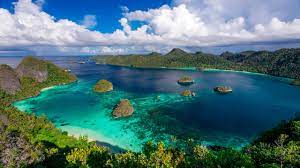
Timing your visit
We were heading to PNG from Solomon Islands and there’s a couple of really important things to mention about the timing of this passage.
There’s loads of chat on Noonsite and other forums about the timing for doing the crossing over the top of PNG and into Indonesia.
Jimmy Cornell makes it very clear that the best time to do it is during July and August, when the winds are south easterly and the current is north easterly setting and that mid November is the latest you can do it.
We met fellow cruisers in the Solomons and Vanuatu who were saying they were going to do the crossing in November or December and saying they felt it didn’t really matter about timing.
Jimmy is right!
It is possible to do the crossing at that time of year, but it’s really worth reminding people that Jimmy Cornell is right – it is likely to be either very unpleasant or fuel depleting to do the crossing after November. We left it as late as we could, crossing in late October and it was pretty awful.
Most of the people that were on the PNG 2023 Facebook group were saying they were going to do it later than us and they all ended up dropping out because they realised it was too difficult and too lage
So in summary, I think it’s really important to note that Jimmy Cornell’s advice is right. When he says Don’t attempt it after mid November – then Don’t attempt it after mid-November!
What you really have to take into account is July and August is perfect for the crossing, September is OK, October is marginal and November is not OK. However, this doesn’t mean it’s fine up until mid-November. It’s like it’s a sliding scale – so my advice is to listen to Jimmy! Doing this at the right time would be a true pleasure – at the wrong time it is expensive and paintful.
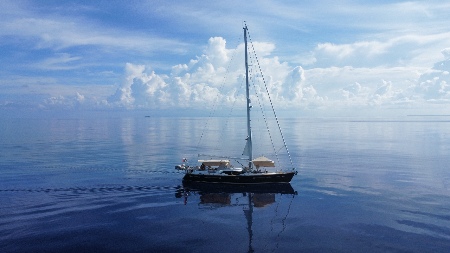

Rabaul
We checked in here because we’d been advised that it was a good place to check into the country.
However, most of the boats that we subsequently met in PNG didn’t check in at Rabaul. They went to the outer islands like Green Island/Nissan Island, travelled the north coast of New Ireland and then checked in and out, simultaneously, at Kavieng.
In hindsight, that seemed seems like a better option than what we did which was to do it “by the book”. We had to stop in Rabul to leave the boat somewhere safe to travel the interior and if that is your plan than Kokopo is the right place to clear in. But if you are short of time then a simultaneous in and out at Kavieng seems to be the simplest approach.
However, be warned that stopping in PNG before clearing in will always carry some risk of being caught. But I think it probably was not the best way of doing it, even though it’s the “legal” way – check in, cruise and then check out of PNG.
A lot of books and cruising guides say that Rabaul is amazing, or used to be amazing before the big volcanic explosion in 1994 that destroyed most of the town.
We anchored in Rabaul to find a big, large commercial harbour full of huge, imposing, international fishing trawlers and felt incredibly, significantly exposed.
We anchored next to the yacht club, which seems by the sound of it quite good, but actually we still felt very exposed. You definitely get the feeling that you are in a big industrial port, but you are also exposed to the wind with quite a big fetch of several miles as well. The wind howled through the anchorage while we were there.
Are we safe?
There’s an ex-pat Aussie by the name of Rod who is the “meet and greet guy” for visiting cruisers in Rabaul. He’s a really friendly guy and he sends nice helpful emails and is very welcoming and on arrival he seems very lovely, but he also scared the crap out of us!
When we arrived, I said to him, “are we safe here?” And he said, “Well, not really.” The yacht club was burgled the night before we got there and had a load of gear stolen, even though they had security guards. I asked him what should we do?
He basically told us that it’s really dangerous and then he showed me cut marks all over his arms and said it was from being attacked by machetes. I asked him what he did for security and he replied that he slept with a shotgun under his bed. I asked him “can you sleep on our boat tonight and we’ll leave in the morning?” He replied: “Oh no, my niece is on my boat and I need to sleep on my boat to make sure she doesn’t get assaulted.”
At this point, I was pretty close to lifting anchor and sailing to Indonesia and just not even checking into PNG!
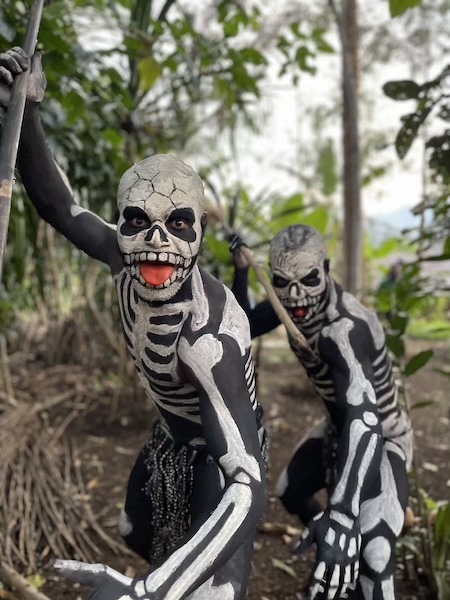

We had planned extensively to anchor in the Duke of York Islands, which are a couple of hours sailing from Rabaul and I asked him about that and he said it was really dangerous and he’d been there and he lifted anchor in the middle of the night because he felt it was too dangerous.
So our entry into Papua New Guinea was to an exposed nasty port, to be met by a very friendly guy who proceeded to tell us that we were basically at high risk of being attacked in our sleep and that there was nowhere safe to go!
Be careful who you listen to
It transpired that the more we found out about Rod, the more time we spent in PNG, the more we formed our own view on the country and its people, the more we realised he had quite a colonialist attitude towards the PNG people. We concluded that he gets treated they way he treats the locals and that’s why he’s getting attacked and he feels unsafe, even though he’s lived there for 20 years.
In reality, most of what he said was not what we experienced. Our short experience of PNG was very different to the picture painted by Rod, by luck or by judgement. My point of re-telling this tale is simply to advise potential visitors to PNG to be careful who you listen to. The most rewarding destinations of our trip, Easter Island, Ducie, Cocos and PNG, are all places that people tried to tell us not to visit.
I think it is important to pass on our experience, in that although Rod is the “meet and greet guy”, he has a certain viewpoint of Papua New Guinea which is one person’s perspective and not to become scared by it.
It kind of ruined my first week because the first person I met made me so scared that it took a long time to calm down.
Rabaul Clearance
Rod did help arrange clearance for us in Rabaul but we also sought assistance from a local agent and I have to say the process was quite slow. No one would come on the boat until all three sets of officials from immigration, customs and quarantine were there. There was a considerable wait for quarantine and once they arrived, everyone came out to the boat at once.
We weren’t allowed to leave the boat in any way – we had to stay on board the boat until the whole process was finished. However, when the officials did turn up, it took maybe 20 minutes and the whole process was actually done pretty efficiently – we were quite impressed.
However, I should warn people about some of the customs officers – Jeffrey in particular – in Rabaul. You need to be on the ball when dealing with them and be prepared for some kind of request or fees that are not appropriate at all.
One of the reasons I wanted to do this article with Noonsite was to talk about questionable customs practices because I hope that once it gets into the public domain and people talk about it, these officials will realise people know about it, so they change because they know the game’s up, it’s become public knowledge. I think it’s important to get it out there so that people who read Noonsite will think, “OK, I need to be aware of that potential situation” and be prepared.
I remember reading about Rabaul and thinking we should go there, but now I would say it’s a bad idea going to Rabaul – I don’t think there’s anything good to say about the place, but that’s just my perspective.
Kokapo
This place is way nicer than Rabaul. You can actually check in here because the customs officials come from Kokapo to Rabaul anyway, so I really would not recommend people go to Rabaul and the yacht club at all – go to Kokapo and do the clearance formalities there.
We anchored off the Kokapo Beach Bungalow (KBB) resort which was a surprisingly wonderful place. There was a super yacht anchored outside, so that’s why we went to check it out and it turns out it’s actually a brilliant anchorage.
The hotel is international quality, it offers tours to the volcano and really good food and we felt really safe there so I would highly recommend anchoring off the KBB in Kokapo.
The other thing to mention is that within 100 metres of that anchorage, is the best supermarket we found between New Zealand and Lombok.
This is almost a New Zealand-quality supermarket, with everything you could possibly imagine, so it’s quite a gem when you’ve been travelling for six months through Vanuatu and the Solomon Islands and haven’t been able to find some of the foods you might be craving such as tomatoes, cheeses or high quality meats.
Duke of York Islands
After Kokapo we went to the Duke of York Islands which are only a few hours sail from Rabaul, because we wanted to leave the boat somewhere safe for two or three weeks to go to visit the highlands of Papua New Guinea.
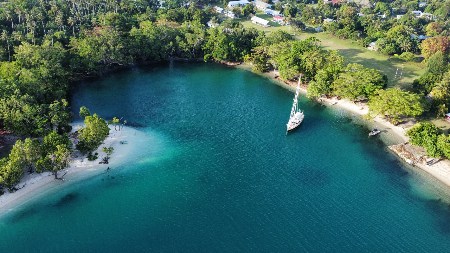

We anchored next to Mioko Island in a near-geographically-perfect anchorage. It benefits from 5m depth with a sandy bottom and fully protected in all directions from waves and winds. With a stern-tie to the beach you are almost totally protected from the strong winds that tumble through the St George’s Channel during the windy season.
Culturally the village is beautiful. It’s full of children and you can hear their laughter all day.
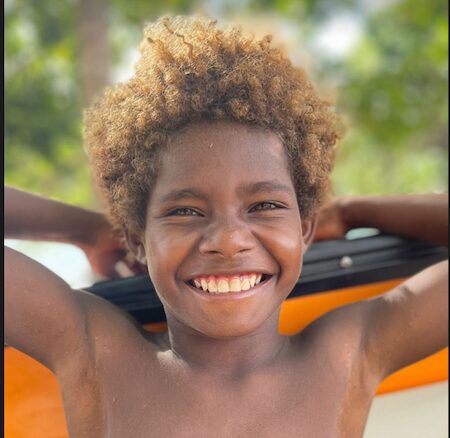

Simon and his three sons run a local guest house and were on the beach to guide us in as we arrived. They understood our security concerns and for K50 (US$5) a day they provided 24-hour security. At night they diligently stayed awake with their torches on and we felt very safe. We made them dinner and coffee before we went to sleep for the night.
Simon is friendly with perfect English, as is his wife. They are very keen to develop this geographically-blessed anchorage into a yachting hub and rightly so. Contact Simon’s son Manuel on WhatsApp +675 7111 4635 in advance to make arrangements. They offer a range of tourist services including transfers to the mainland and a dolphin tour, which was totally epic!
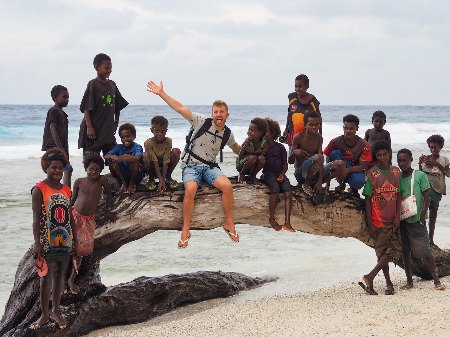

I think it’s helpful for people to be aware that there is a very safe, protected and secure anchorage in north PNG to leave a boat. The reason I’m mentioning it is because we left our yacht there to go to the PNG highlands, which turned out to be an absolute highlight of our stay in the country and where we experienced some of the best culture and festivals in the world. It would be easy to think that is not possible without the knowledge of this anchorage.
Highland Festivals
PNG is most famous for its cultural festivals. Most of us have seen photos of tribes with painted faces and feather headdresses. If possible, it is well worth trying to fit some of the festivals into your itinerary. It will take a fair amount of planning, but it can be done safely and on a tight budget.
The most famous festival is the Mt Hagen Festival is which is usually in August. The Goroka Festival Show is in September and is almost as famous and impressive as Mt Hagen. The Kalam Festival is tiny in comparison but remote and deeply authentic. It is scheduled for the weekend after the Goroka Show, also in September and I think in August there is the Amber TNI. Finally, the Sepik River Crocodile Festival as well as a whole load of other festivals, but those are the four main ones, usually in September. There are many more festivals, but these were the main ones that interested us.
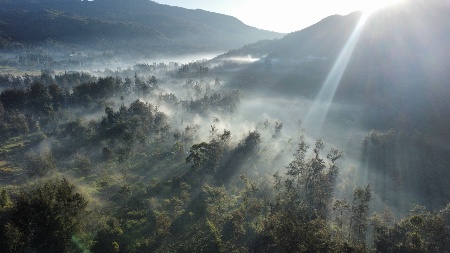

Because of this safe anchorage in the Duke of York Islands and luckily for cruisers, these festivals tie in perfectly with the best optimum weather conditions in July and August to traverse Papua New Guinea’s north coast. So with a little planning, a superb itinerary quickly emerges with dream sailing and unbeatable culture.
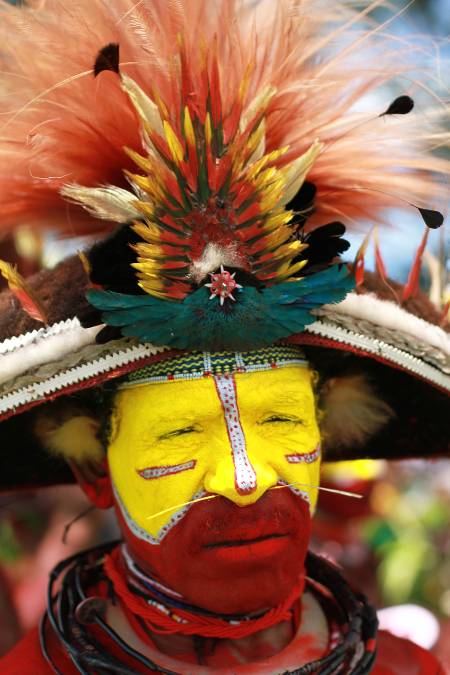

The festivals are like something that you see in the pages of National Geographic magazines – tribes with face paints and amazing, stunning costumes and decorations, but living in a Stone Age world and an electrifying atmosphere.
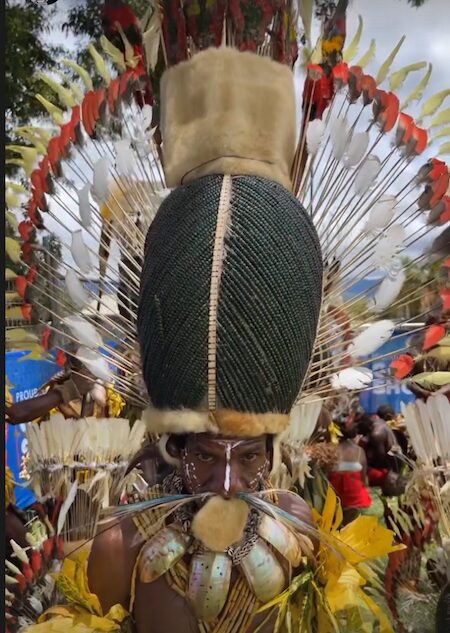

It would be undoubtedly the most impressive culture that we’ve seen anywhere in the world so far. I can highly recommend the experience if you get the chance. You can leave your boat in a safe anchorage, be there during the the season to watch the festivals, come back to your boat and then continue on in perfect weather, for sailing to Indonesia with an arrival at the peak season – November – for Raja Ampat. It’s about a 45 minute journey back to Kokapo from the DOY islands and then it’s a five minute taxi to the airport where you can get a flight to the PNG highlands.
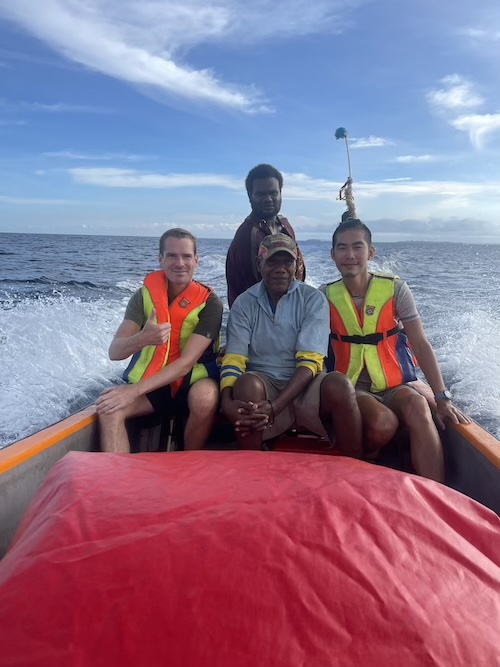

The next stop
The decision on which way to sail after Rabaul/Kokopo/the Duke of York Islands is a key one for cruisers.
Once you’ve gone to Rabaul and the Duke of York Islands, you can either come back out of the Saint George Channel and visit Green Island/Nissan Island and then sail north of New Ireland to Kavieng.
Alternatively, you can keep going naturally with the wind and the current to Kavieng, but it’s quite a serious decision to make. For us, heading south, out of the Saint George’s Channel was really challenging. There was a strong, consistent south-easterly wind and a strong current always flows through that channel, so you can end up against 15 to 20 knots of wind and a couple of knots of current.
Going with the wind and with the current is the obvious choice, but we had decided to go to Green Island because I was pretty worried about security. In the end we made it out of the channel, motoring at 2.5 knots.
We decided to work with an agent to help with advice on where we could go and a safe itinerary. He told us to stay away from all the islands north of New Irelandwith gold mines because the gold mines attract dense populations of people and with it, money, gambling and alcohol, which is not a safe combination and can cause issues for visiting yachts and crew.
Although several of the islands north of New Ireland have got gold mines on them, Green Island/Nissan Island and Boang Island don’t, which is why they are considered safer and which is why we decided to go that way. This turned out to be good sound advice from our agent.
Green Island/Nissan Island
This is probably about as remote as it’s possible to get. The people here live very basic lives in relation to our western lifestyles. They make little houses out of the wood from the rain forest and don’t have any electricity or power or solar panels or any form of technology.
They have small gardens and they catch monkeys from the trees and they’ve got basically nothing. It is pretty much as primitive, sustainable and as simple as I’ve seen anywhere in the world and it was an incredible privilege to witness.
They said that we were the first boat they had anchored at their village for over 10 years, which was pretty cool.
The village is in the south of Green Island and is easy to see as there is a long term yacht stored there. On arrival we went to see the chief there. He invited us to a party, took us hunting and to the beach to see the surf. We spent a week with the villagers and felt like we developed a friendship with them. We gave them reading glasses, sunglasses, antiseptic cream and other gifts and in return they gave us lobster and fruits and vegetables. It was a wonderful and genuine experience.
In the middle of Green Island, which is an atoll like in French Polynesia, in the very centre is a small island with an outstanding reef and excellent snorkelling, which is very impressive. It was some of the best snorkelling we’ve done anywhere. The snorkelling I would rate as one of the top two or three, snorkels I’ve ever done. We did it three days in a row because it was so good.
You can also drift the channel, floating over fields of soft coral and giant clams that were bigger than me.
Lining the side of the channel are white sand beaches with overhanging palm trees and kids laughing and playing in the shallows and wanting to chat to you and it is a totally, magical place!
Before snorkelling, we went through the channel just to have a look at the drop-off and there was a a super pod of between 100 and 200 dolphins. We jumped into the water off the dinghy and the dolphins all swam around us, like a soup of dolphins. It was really something I never thought I would experience.
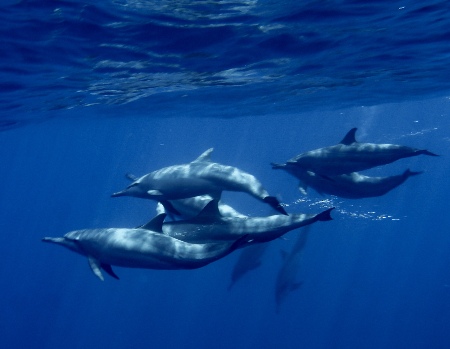

In the very north of the island there is a big village that’s way more developed than in the south. They actually have a bit of power and solar panels and tin roofs.
Green Island is well worth going to if you’re going over the north coast of Papua New Guinea. It was a highlight of our two months in the country. When we were there, three other boats arrived that were all sailing together. They arrived and spent a few days there without having checked in anywhere first and because there is little or no communication or infrastructure on the island at all, I understood they didn’t experience any issues with authorities.
I wouldn’t have done it, but the risk paid off for them – they had no issues at all. I don’t think there was really any way for anyone to find out that they hadn’t checked in. That’s probably what happens a lot of times, given the the state of the corrupt officials and because it is so remote.
I mean, who is going to check on you? They’ve got no way of checking on you, there are no police, let alone customs officials there. I didn’t want to take the risk because I didn’t want to give any officials a reason to be able to cause problems for us, but could totally understand why boats just passing through would try their luck
Boang Island
We were told this was a safe island and on arrival again we found a well protected anchorage and an incredible village called Sungkin.
The chief of the village, Linus Manuel, welcomed us on the beach and made us feel safe. He asks for people to contact him in advance to let him know of their arrival. He told us that if visiting sailors did that he would organise a traditional village welcome with dancing and a fire.
Linus is also keen to trade with visiting yachts. They are keen to trade local produce such as food which they grow including capsicums, sweet potatoes, yams and greens for sugar, rice, tinned meats and canned fish.
It’s a lovely, safe place to stop on the way to Kavieng and there’s a lot to see and do. You can walk around the village, watch traditional dances and enjoy traditional feasts.
Kavieng
Kavieng is the next very obvious place to stop heading west and with a well-known and safe anchorage off Nusa Island Retreat. The guy that runs this resort is super nice and very supportive of visiting yachts. He arranged high-quality diesel for us which was very good diesel and which we needed because there is no fuel available for another 1000 miles after Kavieng.
He took care of us, helped us with customs and immigration officials, arranged for someone to fix our dinghy outboard motor and even sourced eggs for us when there were none available locally.
He employs a few security guards, one of whom came out to the boat, introduced himself and offered his security services to watch the boat. He didn’t take any payment, but made us feel very safe.
However we were advised that the town itself is not that safe. One of our friends went running one evening about 5.30pm and as the sun started to set, locals told him that he had to leave because it wasn’t safe. That was interesting to hear. I think after dark, the town itself is considered quite dangerous, but at Nusa Island Retreat (which is opposite the town but about half a mile away) feels very safe and comfortable.
The owner has been there 20 years and he employs local people and knows everybody and because of that, I think he’s got himself into a little bubble of safety. Everyone’s friends or family or relatives gets benefit from his resort.
Clearance in Kavieng
The two Customs officials in Kavieng are Martin and Deloise. They’re very helpful and friendly and they gave me their email addresses to pass onto any interested cruisers. They also asked me to remind anyone planning to visit Kavieng by boat, to send their pre-arrival form at least 48 hours in advance. They said they’re very happy to deal with visiting sailors directly by email, they were brilliant.
Some people checked in and out at Kavieng on the same day and I think that seemed to work quite well for those who wanted to do it that way.
However, if you check in somewhere like we did in Rabaul, then you have to get an intra-port clearance. Unfortunately, I didn’t do this and we were quite close to getting in a lot of trouble and probably having to pay quite a big bribe.
So it’s really important that people are aware that you can’t get away without doing an intra- port clearance. You will get skewered for it. You have to get it from the either the customs officer or the harbour master in the port that you’re leaving.
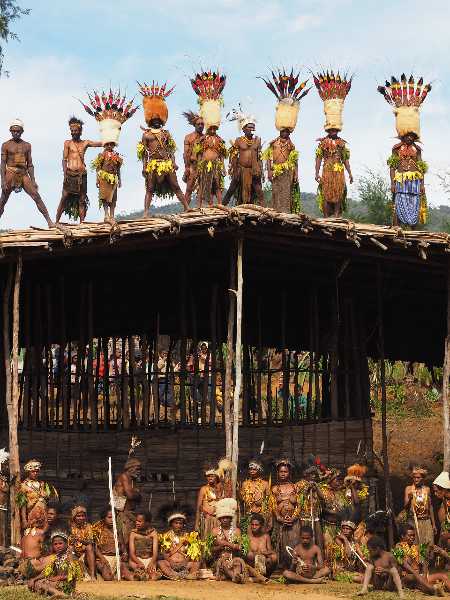
So in Rabaul you would have to get an intra-port clearance from Rabaul to Kavieng. However, there’s no other port basically along the way where there are Harbour Masters, only the major ports.
So get an intra-port clearance from Rabaul to Kavieng and then on the way you can stop off where you want,
Security and Safety
A lot of people get put off the idea of cruising PNG due to security and safety issues. Almost every cruiser we talked to said they would never go to Papua New Guinea.
In my experience of sailing, the more people tell you not to go to a place, the better that place will be because it means that most people are too scared to go there.
Papua New Guinea was definitely an example of that. Most people were telling us not to go, but in the end it turned out to be one of the most incredible countries we have visited. However because a lot of people told me not to go, I took the responsibility of sailing there very seriously.
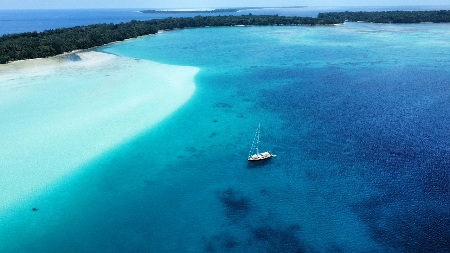

There are a few steps that I would very strongly suggest people take into consideration before heading there by yacht, in order to feel safe.
1. Make a local responsible for your safety
In each of the places we stopped at, we put quite a lot of effort into finding the village chief, meeting him, having a meal with him, giving him gifts, making sure he confirmed that we were safe. Although not as manipulative as it sounds, the effects of this friendly and inclusive approach was to create some form moral responsibility for our safety.
That approach worked very well and we slept very soundly at night with the feeling that the community was looking out for us. It felt like the community also appreciated the respect that we gave them in taking time on arrival to get to know them.
2. Travel with other boats
I think this is very important. We travelled with another boat and the few boats that we met were travelling in company as three or four boats together. Travelling as a lone boat in Papua New Guinea is possible, but I think it’s ill-advised. With another boat, you feel like you’ve got someone else watching out for you. As a lone boat, it would be quite hard to go off and do things and leave your boat unattended. I don’t think it’s impossible, but it’s unwise.
3. Leave nothing on deck
From the Solomon Islands onwards, leave nothing on deck at night and even during the day, nothing should be left unattended.
We read reports from people saying Papua New Guinea was so dangerous and they had so much stolen from their boat. If you leave fishing rods out at night, the tender on the back of the boat or in the water and loose items on deck, of course it’s going to get stolen.
The communities that we met have so little material wealth compared to even the most humble of cruisers. When they see things lying around I don’t think they even think of it as stealing. So we don’t have much sympathy for people who report getting stuff stolen from their decks when they haven’t taken precautions. The one time we left our mobile phones exposed, they got stolen, but we felt that we were really the only ones to blame.
4. Light up at night
We had the deck lit up all night with floodlights. It helped avoid the feeling that the boat could be sneaked up on, undercover of darkness.
The floodlights were fitted to the boat specifically for the trip to Papua New Guinea and in retrospect, it was a sensible idea. I definitely felt very happy to have done this because it meant the boat was a lot less attractive for someone because they couldn’t sneak up on the boat at night which added to our sense of safety at night.
5. Install a camera
We also fitted a cheap security camera to the boat, on the stern communication pole at the back, with a motion sensor connected to the boat’s WiFi. If it detected motion, my phone would alert me and I could see what was happening on deck, without going on deck. That was really helpful because I didn’t feel like I had to approach an intruder in the night. I could just look on my phone and see what was going on. Every time it went off, it was because there was a bird or something, but I do think again, it felt like a cheap and sensible precaution to take that added to our sense of safety.
Also, from an insurance perspective, if anything did happen, you’d have it all recorded on a camera, which again, I think is quite sensible.
6. Install motion sensors
Another adaptation that we made specifically for PNG, was to fit a series of motion sensors underneath the deck. We glued them to the underside of the hull under the teak deck plate, on the inside of the boat. We put tin foil underneath them so they didn’t pick up our movements inside the boat, but only people moving on deck. This was linked to an an alarm system so should there have been an intruder we would all have woken up, as well as alerting our buddy boat and likely putting off the intruder who would have lost the benefit of surprise. This is a slightly more complex adaptation that may not be suitable for many, but we found it surprisingly effective and comforting.
7. Keep in contact with your buddy boat
A simple and effective precaution is to keep the ship the radio on at night and on the same channel as our your buddy boat. Our plan was that if either of us were boarded in the night, we could radio the other boat to seek assistance.
8. Pre-plan your Itinerary
We decided where we were going to go and we made sure that we had email contact with someone there in advance. This meant that someone was expecting us at each of the anchorages we arrived at. Wherever we went, we had somebody that knew we were coming and took some degree of responsibility for us and I really think that’s important in PNG.
My personal opinion is that you are opening yourself up to significant risks by sailing around and stopping where you want on a whim – as we do most places in the world. I think if you just anchor where you want willy nilly there is a chance that you will have a problem and that was a risk I was not prepared to take as any violent encounter could have turned the circumnavigation from a dream to a nightmare.
By pre-planning all our anchorages in advance, we felt that risk was really minimised.
A Country with a Reputation
I think it’s fair to say that after spending almost eight weeks in Papua New Guinea I wouldn’t have done the trip without doing all of the things I have suggested in this report, in preparation for our journey.
The country had a reputation for limited law and order for a reason. For instance, Kokopo airport was closed for two days before we flew out to the highlands, because it was rioted by 20 armed gunmen who attacked some of the check in staff and stole the computers.
While we were at the Goroka Show in the highlands there was a gun fight with police which resulted in a stampede and we had to lock ourselves in in the toilets until we were evacuated by police.
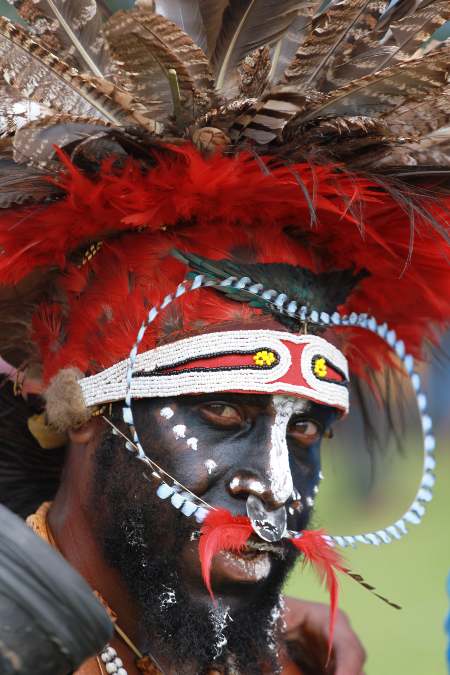

It’s a country where violent crime is never that far away, but it is definitely worth visiting. However, it’s not the kind of country where you can just travel around like you have been doing in the Pacific. It has a reputation and it deserves this reputation, but all that means is assessing the risks and taking steps to mitigate them as much as you are able to, which means you always need to be on the ball.
Do your homework and reap the rewards
Papua New Guinea really is a great place to go, but do your preparation and don’t just rock up to an anchorage expecting to have no problems.
You have to be totally aware that you are in the back of beyond and you have a big, nice, shiny yacht and they have very little. The level of violent crime in PNG is a complete step up – it’s a totally different level from the Solomon Islands.
In the Solomons, it feels like someone could be a bit nasty to you, or you might get something stolen, but in Papua New Guinea, there’s always this feeling that someone could get on board with a gun and kill you.
In some areas, the price of life in Papua New Guinea felt very cheap and I believe it is important to be aware of that.
But if you take the right precautions it will massively pay off with experiences that are right out of National Geographic magazine.
James Ashwell
SV Uhuru of London
………………………………
About the Author
James Ashwell and his crew left London in 2017 on a “lazy circumnavigation”. They have spent the past six years cruising the Pacific and visited the Solomon Islands before their Papua New Guinea experience. They are now in Indonesia where they plan to spend 12 months cruising this archipelago.
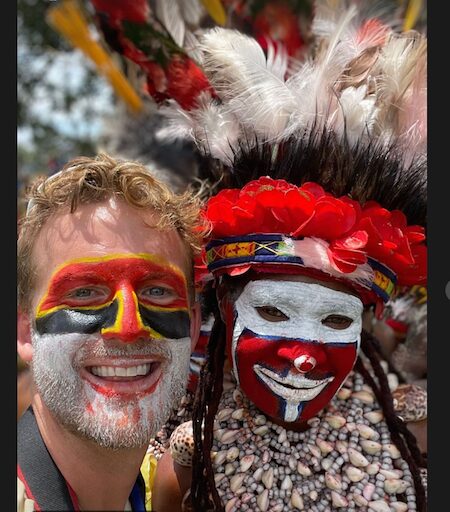

………………………………
Other Noonsite reports from James:
………………………………
The opinions expressed in this article are the author’s own and do not reflect the view of Noonsite.com or World Cruising Club.
………………………………
Find out all news, reports, links and comments posted on Noonsite, plus cruising information from around the world, by subscribing to our FREE monthly newsletter. Go to https://www.noonsite.com/newsletter/.
Related to following destinations: Kavieng, New Britain Island, New Ireland, Nissan Island, Other Outer Islands (PNG), Papua New Guinea, Rabaul
Related to the following Cruising Resources: Circumnavigation, Routing, Timor Sea




Much appreciate the article and contact info. Very helpful.